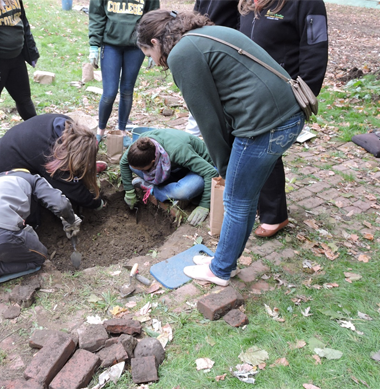Tracing Albany’s Underground Railroad
UAlbany field school provides practical training for archaeology profession
 |
|
The field school will teach students how to lay out units, excavate, screen, map, record, and photograph archaeological features at the sites.
|
ALBANY, N.Y. (May 9, 2017) -- During the 19th century, Albany was home to several figures who supported the Underground Railroad – the secret network of routes and safe houses that helped African-American slaves escape to freedom. This summer, a team of UAlbany researchers and students will examine the physical evidence left behind at their homes, with the goal of improving our understanding of their efforts and preserving the historical record.
The archaeological field school will teach students to lay out units, excavate, screen, map, record, and photograph archaeological features at the sites. Students who complete the school will have gained valuable skills they could use to apply for federal and state jobs on construction sites, in labs or at museums.
The sites for this year’s school include the Ten Broeck mansion and the homes of Stephen and Harriett Myers and Thomas Elkins, all key figures in Albany's underground railroad.
“At Ten Broeck mansion, we will search for servants' quarters and other key activity areas,” said Professor of Anthropology Marilyn Masson, director of the field school “All properties are owned by historical societies, and this collaboration will very much involve the community.”
It is also an interdisciplinary undertaking, especially for history and archaeology, but also related social science and humanist fields. For instance, in the case of Stephen and Harriet Myers, a written legacy remains that documents their role in helping hundreds of slaves make their way through Albany on the road to Canada. Stephen Myers, along with Elkins, both served on the “vigilance committee” in Albany, with the goal of counteracting slave catchers by providing legal assistance, food, clothing, money and temporary shelter to escaped slaves.
At the field school, students will examine the physical evidence left behind at their homes to supplement the historical record. Students who take part will also learn to wash, label, identify, and inventory artifacts in the lab, which are useful and expected skills for entry-level work in the archaeology profession.
Masson will team with two local archaeology experts, Matthew Kirk of Hartgen & Associates, who is completing his Ph.D. in anthropology at UAlbany, and Michael Lucas, curator of historical archaeology at the New York State Museum.
The field school is open to all undergraduate students, as well as high school students entering 12th grade. The six-credit program will run from June 26 through August 4.
Interested students should contact Dr. Masson at [email protected].
![]() For more news, subscribe to UAlbany's RSS headline feeds
For more news, subscribe to UAlbany's RSS headline feeds
A comprehensive public research university, the University at Albany-SUNY offers more than 120 undergraduate majors and minors and 125 master's, doctoral and graduate certificate programs. UAlbany is a leader among all New York State colleges and universities in such diverse fields as atmospheric and environmental sciences, business, education, public health,health sciences, criminal justice, emergency preparedness, engineering and applied sciences, informatics, public administration, social welfare and sociology, taught by an extensive roster of faculty experts. It also offers expanded academic and research opportunities for students through an affiliation with Albany Law School. With a curriculum enhanced by 600 study-abroad opportunities, UAlbany launches great careers.


